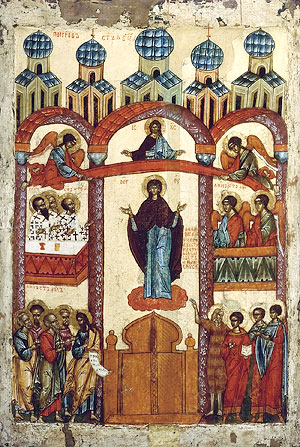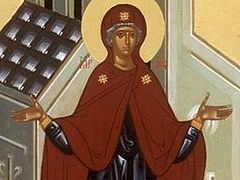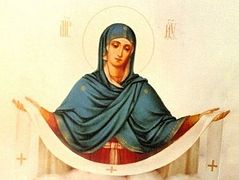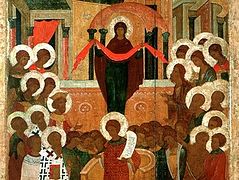
But not everyone shares this faith, and not all the faithful always stand firm in it. This begins in the latter during such hours when they ardently pray for something and, as it seems to them, did not receive it. Doubts arise: is it really true that there is the Protection of the Mother of God and the saints? Who has ever seen it with his own eyes or at least perceived the traces of its covering? Could it be a deception of romantic peoples’ feelings, a figment of their imagination, created by a heated mind? This is how unbelief wants to turn the entire faith and its miracles into nothing more than a figment of the imagination and a deception. Thus do the unbelieving want also to turn Christ’s Resurrection into a phantom supposedly imagined by Mary Magdalene and the apostles, who fervently waited for it. And they do not want to remember or know that Mary Magdalene and the apostles were not fervently waiting for the Resurrection, for they didn’t even think about it—Mary Magdalene went to anoint Jesus’s dead body, and when she saw the Risen Christ she thought He was the gardener; the apostles said disappointedly, But we had hoped that he was the one who was going to redeem Israel. And what is more, it is the third day since all this took place (Lk. 24:21). Then, when they saw Him, they thought that they were seeing a phantom—however, Mary Magdalene clasped Jesus’s feet, and the disciples touched Christ. He ate and drank with them—something that no phantom could do.
Even if only St. Andrew and Epiphanius saw the Protection of the Mother of God, don’t we know that her Divine Protection invisibly spreads across the whole world? Could it be that the one who from the very first days when her Divine Son began His preaching to the world asked Him about the wine running out at the marriage in Canaan of Galilee, would after departing to heaven cease to ask and pray for the human race? Could the one whose Son said from the Cross, Woman! Behold thy son! and adopted through the apostle John the whole Christian race, cease to defend with maternal love and pity her new children? Could the one who all her life prayed much and lifted up her hands until her very blessed Dormition cease to lift up her hands in prayer, when she took her place as Queen on the right hand of her Son and God, when He could no longer refuse her intercessions “as an indebted Son”[2]? That is why the Protection of the Mother of God spread over the world has always been visible to the eyes of faith, perceived and tangible.
If an unbelieving person does not see it, what is so remarkable about that? Can diseased or blind eyes see well? Many who have eyes either might not see, do not believe their eyes, or try to reinterpret as they like everything they’ve seen. Wasn’t that how many of the Jews interpreted Christ’s miracles, which they saw with their own eyes but tried to ascribe them to the workings of Beelzebub, as if satan could take up weapons against himself and work miracles that defeat his own operations and kingdom? Unbelief often depends on whether person wants or does not want to believe. A healthy person often does not want to believe he is sick at the onset of his disease, and no matter how you try to convince a hypochondriac that he is healthy, he will continue to look for more and more illnesses in himself. When a person loves someone passionately she sees neither any of his faults, nor her own passionate attachment, according to which she might do many things for her beloved against her own conscience and injurious to others; while a man blinded by hatred sees only evil even in the good deeds and intentions of the one he hates. So also does the passion of drunkenness, as well as the passion of fornication, and so on, blind a man! No matter how you tell such a person about the harm that comes from his passion, he will always assure himself, “There is nothing wrong with it, nothing will happen, and if something does happen it will be but a trifle and soon pass.” This is what the person blinded by passion will say even if he has already experienced the harmful consequences of his passion, drunkenness, fornication, and so forth. For example, when a drunkard is shown a graphic image of what happens to his stomach, heart, and other organs from drinking, he doesn’t believe something that is not totally visible to him now, when the harm awaits him in the future. Such objects of faith are mostly unseen and have to do with the future. Such a person is warned, “Do not walk next to a precipice—keep way from it,” and he goes there; they tell him, “Don’t go near the enemy,” and he goes there, telling himself, “Perhaps there is no enemy, and nothing will happen to me.” How could such eyes blinded by passion see the Protection of the Mother of God over the world?
A natural scientist can recreate an animal that no one has seen from bones found in the earth and describe how that animal lived, and people believe him. But in the realm of faith—Christ’s enemies have seen Him alive and seen His miracles with their own eyes, yet they do not believe. If someone finds an axe in the earth, he says that a man must have lived in that place, because it takes human intelligence to make an axe. But when they look a the world filled with wisdom that is immeasurable and incomprehensible to the human mind, many do not want to exclaim, “Wondrous are Thy works, O Lord! In wisdom hast Thou made them all!” They want to see in this wondrous creation the work of blind coincidence. This is how blind unbelief is. Seeing but not seeing it often also voluntarily blinds its own eyes, because it just doesn’t want to see.
On the other hand, a person’s vision becomes sharper according to the measure of his desire to see something and carefully watch it. At first there is much the eyes do not see, then by straining and increased attention they begin to notice and discern clearly. Isn’t that how it is when someone comes out of a bright place into a dark field—first he doesn’t see anything, then after looking around he begins to discern many things the darkness, such as roads, pits, trees, etc.? Especially when a person is very interested in something and needs to see it his vision becomes ever sharper. A sailor peers during a storm into the dark distance and notes the outline of a shore. A jealous lover notices with great exactness and interprets the slightest movement of the one for whom he is jealous. Then when out of his desire and love he gains knowledge, things become easier to see clearly. A doctor immediately sees an illness, a natural scientist immediately determines the species of a plant, animal, or soil type, and so on. Isn’t it the same with faith in Divine miracles, in the Protection of the Mother of God, which is invisible to the coarse physical eye and to the eye that is dimmed by passions and not sharp enough for this vision, due to carelessness and failure to bridle those passions?
Let us ever refine this eye through careful contemplation of God’s wondrous works in the world, and sharpen our vision of spiritual desire and love for God. Then, in the spiritual world, we will resemble not the blind Jews, who “saw but didn’t see” Christ’s miracles. But let us be as the prophets of God, the apostles, and the saints, who forsaw the Lord always before them (cf. Ps. 15:8); who saw everywhere around them the marks of His presence, believing that the Lord is near (Ps. 144:18); who could “see the future as if present,” and walk by faith, not by sight (2 Cor. 5:7). And refining this vision of the God’s action guidance in the world, life becomes peaceful, blessed, and righteous, because we are going where Christ leads us—a direction visible to the eyes of faith, to the Mother of God and the saints, but not to the eye of the heart blinded by passions, which can easily lead one into the abyss of perdition. A blind man easily falls into the ditch, especially when he is follows after the one who blinds his spiritual eyes, the “prince of this world”—the devil—who walketh about, seeking the human souls he may devour (1 Pet. 5:8). Amen.



